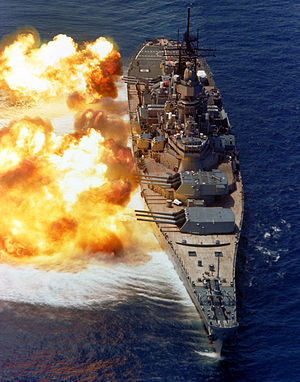
Back يو إس إس آيوا (بي بي-61) Arabic Айова (линеен кораб, 1942) Bulgarian USS Iowa (BB-61) Catalan USS Iowa (BB-61) Czech Iowa (Schiff, 1943) German USS Iowa (BB-61) Spanish یواساس آیووا FA USS Iowa (BB-61) Finnish USS Iowa (BB-61) French איווה (BB-61) HE
 USS Iowa unleashes a broadside of nine 16-inch guns on 15 August 1984 during a firepower demonstration after her modernization
| |
| History | |
|---|---|
| Namesake | State of Iowa |
| Ordered | 1 July 1939 |
| Builder | New York Naval Yard |
| Laid down | 27 June 1940 |
| Launched | 27 August 1942 |
| Sponsored by | Ilo Wallace |
| Commissioned | 22 February 1943 |
| Decommissioned | 24 March 1949 |
| Recommissioned | 25 August 1951 |
| Decommissioned | 24 February 1958 |
| Recommissioned | 28 April 1984 |
| Decommissioned | 26 October 1990 |
| Stricken | 17 March 2006 |
| Identification | Hull symbol: BB-61 |
| Motto | "Our Liberties We Prize, Our Rights We Will Maintain" |
| Nickname(s) |
|
| Honors and awards | |
| Fate | Museum ship |
| Status | On display at the Pacific Battleship Center at the Port of Los Angeles (33°44′32″N 118°16′38″W / 33.7423°N 118.2772°W) |
| Badge |  |
| General characteristics | |
| Class and type | Iowa-class battleship |
| Displacement |
|
| Length | 887 ft 3 in (270.43 m) |
| Beam | 108 ft 2 in (32.97 m) |
| Draft | 37 ft 2 in (11.33 m) (full load) |
| Installed power |
|
| Speed | 33 knots (38 mph; 61 km/h) |
| Complement | 151 officers, 2,637 enlisted (WWII) |
| Armament |
|
| Armor | |
| Aircraft carried | floatplanes, helicopters, UAVs |
USS Iowa (BB-61) is a retired battleship, the lead ship of her class, and the fourth in the United States Navy to be named after the state of Iowa. Owing to the cancellation of the Montana-class battleships, Iowa is the last lead ship of any class of United States battleships and was the only ship of her class to serve in the Atlantic Ocean during World War II.
During World War II, she carried President Franklin D. Roosevelt across the Atlantic to Mers El Kébir, Algeria, en route to a conference of vital importance in 1943 in Tehran with Prime Minister Winston Churchill of the United Kingdom and Joseph Stalin, leader of the Soviet Union. When transferred to the Pacific Fleet in 1944, Iowa shelled beachheads at Kwajalein and Eniwetok in advance of Allied amphibious landings and screened aircraft carriers operating in the Marshall Islands. She also served as the Third Fleet flagship, flying Admiral William F. Halsey's flag at the Japanese surrender in Tokyo Bay.
During the Korean War, Iowa was involved in raids on the North Korean coast, after which she was decommissioned into the United States Navy reserve fleets, better known as the "mothball fleet." She was reactivated in 1984 as part of the 600-ship Navy plan and operated in both the Atlantic and Pacific Fleets to counter the recently expanded Soviet Navy. In April 1989, an explosion of undetermined origin wrecked her No. 2 gun turret, killing 47 sailors.
Iowa was decommissioned for the last time in October 1990 after 19 total years of active service, and was initially stricken from the Naval Vessel Register (NVR) in 1995, before being reinstated from 1999 to 2006 to comply with federal laws that required retention and maintenance of two Iowa-class battleships. In 2011 Iowa was donated to the Los Angeles–based non-profit Pacific Battleship Center and was permanently moved to Berth 87 at the Port of Los Angeles in 2012, where she was opened to the public as the USS Iowa Museum.
- ^ "The Battleship of Presidents' final sail". milmag.com. 1 July 2012. Archived from the original on 9 December 2018. Retrieved 9 December 2018.
- ^ Hyperwar: BB-61 USS Iowa Retrieved 1/7/23